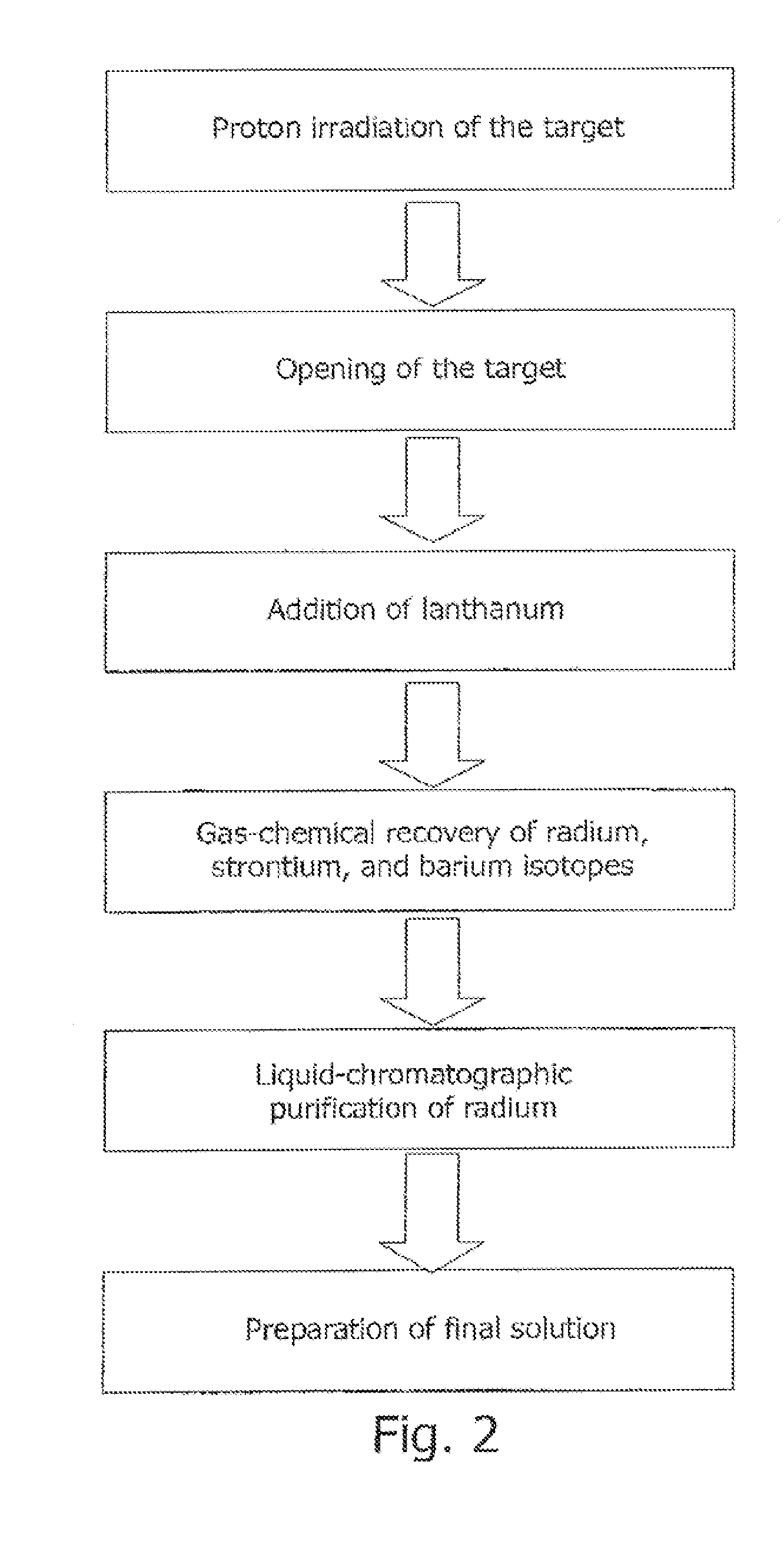Method for producing actinium-225 and isotopes of radium and target for implementing same
a technology of actinium-225 and isotopes, applied in the field of nuclear technology and radiochemistry, can solve the problems of limited raw material availability, low production potential, and hazard of radium salts
- Summary
- Abstract
- Description
- Claims
- Application Information
AI Technical Summary
Benefits of technology
Problems solved by technology
Method used
Image
Examples
example 2
[0089]A target is manufactured (FIG. 5). A bulk metallic thorium monolith (2) shaped as a disk 7 mm thick and 45 mm in diameter is vacuum diffusion welded to inlet windows (5) made of a hot-rolled molybdenum foil 100 μm thick electrolytically coated with nickel (the nickel thickness is 60 μm). Temperature is about 900° C.; the specific pressure is 280 kg / cm2. The welded part is additionally sealed by electron-beam welding with niobium rings (6) 0.5 mm thick. The target is irradiated by a proton beam directed normal to the target with a current of 100 μA and an initial energy of 110 MeV.
[0090]Following irradiation, nickel is etched off with 1 M nitric acid for 2 hours, and the inlet and outlet windows (5) are dissolved in 100 ml of 50% hydrogen peroxide.
[0091]After being withdrawn from the shell (1′) made of niobium or nickel-coated hot-rolled molybdenum, thorium is dissolved in concentrated nitric acid under heating, the medium is brought to 5 M nitric acid (the solution volume reac...
example 3
[0098]A target is manufactured (FIG. 6), comprising a bulk metallic thorium monolith (2) shaped as an elliptic plate 4.5 mm thick diffusion-welded to a foil (5) made of austenitic stainless steel inside a case (1) made of austenitic stainless steel. The target is additionally sealed along the perimeter thereof by means of an argon-arc welded L-shaped stainless steel ring (7).
[0099]The target is irradiated in a proton accelerator with a current of 70 μA and proton energies in a range of from 100 to 80 MeV.
[0100]Following the withdrawal from the shell, thorium is dissolved in concentrated nitric acid under heating, the medium is brought to 4 M nitric acid (the solution volume reaches 1 l), and an equal volume of a 0.5 M solution of tri-n-octylphosphine oxide in toluene is added. Following the extraction, the solution is separated into an aqueous phase and an organic phase, and the extraction is repeated one more time. The aqueous phase is concentrated to dryness, concentrated perchlor...
PUM
| Property | Measurement | Unit |
|---|---|---|
| thickness | aaaaa | aaaaa |
| thickness | aaaaa | aaaaa |
| thickness | aaaaa | aaaaa |
Abstract
Description
Claims
Application Information
 Login to View More
Login to View More - R&D
- Intellectual Property
- Life Sciences
- Materials
- Tech Scout
- Unparalleled Data Quality
- Higher Quality Content
- 60% Fewer Hallucinations
Browse by: Latest US Patents, China's latest patents, Technical Efficacy Thesaurus, Application Domain, Technology Topic, Popular Technical Reports.
© 2025 PatSnap. All rights reserved.Legal|Privacy policy|Modern Slavery Act Transparency Statement|Sitemap|About US| Contact US: help@patsnap.com



